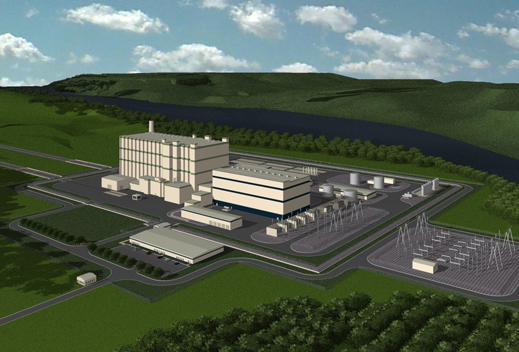TerraPower Quietly Explores New Nuclear Reactor Strategy
Among the growing field of startups attempting to bring advanced nuclear reactors to market, TerraPower stands out—partly because it’s well-funded, and partly because of who’s doing the funding. TerraPower is a spin-off of Intellectual Ventures, the technology investment firm founded by Microsoft cofounder Nathan Myhrvold. Bill Gates is both a primary investor in and a vocal champion of the company (see “Q&A: Bill Gates”). The company has also drawn attention because it’s pursuing a novel reactor technology, known as a traveling wave reactor, that is elegant in conception and powerful in potential (see “Advanced Reactor Gets Closer to Reality” and “Nathan Myhrvold: The Wealthy Should Fund Innovation”).

But six years after it was founded, TerraPower has not yet produced a working prototype. Last week, at Oak Ridge National Laboratory in Tennessee, the company revealed that it is now pursuing a different advanced reactor concept: a molten chloride reactor that uses a liquid as both the coolant, which transfers energy in the form of heat, and the fuel in which the nuclear reactions occur.
“The traveling wave reactor was the focus of our early work, and it’s still the baseline product of the company,” said Jeff Latkowski, the director of innovation at TerraPower, at the Oak Ridge event, a 50th anniversary commemoration of the original molten salt reactor experiment. “But we are looking at other projects that we believe address the three critical areas for nuclear power: safety, the environment, and costs.”
To be sure, this is not the first time that TerraPower has adjusted or augmented its technology strategy. While its terminology has not changed, the company early on modified the “traveling wave” design, in which the nuclear reaction moves like a wave through the fuel, transforming uranium into plutonium, moving to what could be called a “standing wave” design, where the fuel itself is continually shuffled out of the central region of the core. Then-CEO John Gilleland said in 2013 that the company had quietly begun exploring alternative nuclear technologies, including molten salt reactors (of which the molten chloride design is a specific version) and machines that run on thorium, an alternative nuclear fuel that is cleaner, safer, and more abundant than uranium.
Latkowski’s Oak Ridge talk, though, was the first time the company has revealed publicly its Plan B technology. Molten salt reactors offer safety and economic advantages over conventional solid-fuel machines: because the fuel is liquid, the reactions slow as the fuel heats up. And a meltdown is physically impossible: in the event of an accident, the fuel automatically drains into a sealed underground chamber where it can cool off on its own, without the need for external pumping systems like the ones that failed at the Fukushima Daiichi nuclear plant in 2011.
Latkowski declined to go into details on the new reactor design. But he listed some of the other reasons why the molten chloride design is attractive: there’s no fuel fabrication required, the power density of the fuel is very high, as is the efficiency (i.e., the percentage of available energy produced from the fuel), there’s no ongoing uranium enrichment needed after startup (which reduces the risk of nuclear weapons proliferation), the solubility of uranium in the chloride solution is high, and waste from one machine could be used to run another plant. “We can sustain a whole fleet this way,” said Latkowski.
Still, the unveiling of the molten chloride concept raises the question: has TerraPower’s commitment to its original technology, the traveling wave reactor, diminished? Many nuclear industry observers have been skeptical about the concept from the outset. The traveling wave is a subspecies of a sodium-cooled fast reactor, and the track record of those reactors is not encouraging. A prototype French reactor, called Superphénix, built in the early 1980s, operated at less than 7 percent of capacity for 11 years before being shut down in 1996. The Monju reactor, built in Japan in the early 1990s, was shut down for five years after a sodium leak and fire in 1995. The machine was restarted briefly before another accident occurred in 2010. It has not been restarted.
“The problem with sodium is that it has been pretty much impossible to prevent leaks,” says nuclear physicist M.V. Ramana, a lecturer at Princeton University’s Program on Science and Global Security and the Nuclear Futures Laboratory. “Fast reactors in general have never been commercially viable, and I haven’t seen anything from TerraPower that suggests that their design will fare any better.”
Nevertheless, TerraPower remains fully committed to the traveling wave design, says Latkowski. The company recently signed a high-profile partnership with China National Nuclear Corp. to help commercialize the technology. TerraPower also just opened a laboratory and machine shop of more than 20,000 square feet in Bellevue, Washington. The answer to whether the company is moving away from traveling wave reactors “is a wholehearted ‘no,’” says Latkowski.
“From the very beginning we have evaluated multiple technologies over time, and we continue to do so,” he adds. “The [molten chloride reactor] is one that has bubbled up to the point where we’ve gotten more serious about it.”
Keep Reading
Most Popular
Large language models can do jaw-dropping things. But nobody knows exactly why.
And that's a problem. Figuring it out is one of the biggest scientific puzzles of our time and a crucial step towards controlling more powerful future models.
How scientists traced a mysterious covid case back to six toilets
When wastewater surveillance turns into a hunt for a single infected individual, the ethics get tricky.
The problem with plug-in hybrids? Their drivers.
Plug-in hybrids are often sold as a transition to EVs, but new data from Europe shows we’re still underestimating the emissions they produce.
Stay connected
Get the latest updates from
MIT Technology Review
Discover special offers, top stories, upcoming events, and more.